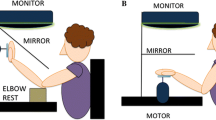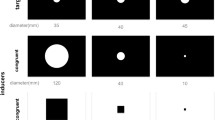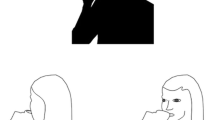Abstract
Although the effect of visual illusions on overt actions has been an area of keen interest in motor performance, no study has yet examined whether illusions have similar or different effects on overt and imagined movements. Two experiments were conducted that compared the effects of an orientation illusion on an overt posture selection task and an imagined posture selection task. In Experiment 1 subjects were given a choice of grasping a bar with the thumb on the left side or right side of the bar. In Experiment 2 subjects were instructed to only imagine grasping the bar while remaining motionless. Subjects then reported which side of the bar their thumb had been placed in imagined grasping. Both the overt selection and imagined selection tasks were found to be sensitive to the orientation illusion, suggesting that similar visual information is used for overt and imagined movements, with both being sensitive to an orientation illusion. The results are discussed in terms of the visual processing and representation of real and imagined actions.




Similar content being viewed by others
References
Aglioti S, De Souza J, Goodale MA (1995) Size-contrast illusions deceive the eye but not the hand. Curr Biol 5:679–685
Brenner E, Smeets J (1996) Size illusion influences how we lift but not how we grasp an object. Exp Brain Res 111:473–476
Bridgeman B, Peery S, Anand S (1997) Interaction of cognitive and sensorimotor maps of space. Percept Psychophys 59:456–469
Brouwer AM, Middelburg T, Smeets JB, Brenner E (2003) Hitting moving targets: a dissociation between the use of the target’s speed and the direction of motion. Exp Brain Res 152:368–375
Desmurget M, Epstein CM, Turner RS, Prablanc C, Alexander GE, Grafton ST (1999) Role of the posterior parietal cortex in updating reaching movements to a visual target. Nat Neurosci 2:563–567
Dixon P (1998) Why scientists value p values. Psychon Bull Rev 5:390–396
Dixon P (2003) The p value fallacy and how to avoid it. Can J Exp Psychol 57:189–202
Frak V, Paulignan Y, Jeannerod M (2001) Orientation of the opposition axis during mentally simulated grasping. Exp Brain Res 136:120–127
Franz VH, Fahle M, Bulthoff H, Gegenfurtner K (2001) Effects of visual illusions on grasping. J Exp Psychol: Hum Percept Perform 27:1124–1144
Gentilucci M, Chieffi S, Daprati E, Saetti M, Toni I (1996) Visual illusion and action. Neuropsychologia 34:369–376
Gentilucci M, Daprati E, Toni I, Chieffi S, Saetti M (1995) Unconscious updating of grasp motor program. Exp Brain Res 105:291–303
Glover S (2004) Separate visual representations in the planning and control of actions. Behav Brain Sci 27:3–76
Glover S, Dixon P (2001a) Motor adaptation to an optical illusion. Exp Brain Res 137:254–258
Glover S, Dixon P (2001b) Dynamic illusion effects in a reaching task: evidence for separate visual representations in the planning and control of reaching. J Exp Psychol: Hum Percept Perform 27:560–572
Glover S, Dixon P (2004) Likelihood ratios: a simple, intuitive statistic for empirical psychologists. Psychon Bull Rev 11:791–806
Goodman SN, Royall R (1988) Evidence and scientific research. Am J Public Health 78:1568–1574
Haffenden AM, Schiff KC, Goodale MA (2001) The dissociation between perception and action in the Ebbinghaus illusion: nonillusory effects of pictorial cues on grasp. Curr Biol 11:177–181
Heath M, Rival C, Binsted G (2004) Can the motor system resolve a premovement bias in grip aperture? Online analysis of grasping the Muller–Lyer illusion. Exp Brain Res 158:378–384
Johnson SH (2000) Thinking ahead: the case for motor imagery in prospective judgments of prehension. Cognition 74:33–70
Milner AD, Goodale MA (1995) The visual brain in action. Oxford University Press, Oxford
Rosenbaum DA, Vaughn J, Barnes H, Jorgensen M (1992) Time course of movement planning: selection of handgrips for object manipulation. In: Meyers DE, Kornblum S (eds) Attention and performance XIV: synergies in experimental psychology, artificial intelligence, and cognitive neuroscience. MIT Press, Boston
Stelmach GE, Castiello U, Jeannerod M (1994) Orienting the finger opposition space during prehension movements. J Motor Behav 26:178–186
Acknowledgements
This work was supported by the Natural Sciences and Engineering Research Council of Canada, through a fellowship to SG and a grant to PD, through a grant from the Economic and Social Research Council of the UK to SG, and through grants from the Wellcome Trust, the MRC, and the Royal Society to MFSR. The authors wish to express their gratitude to Brian Baker for his technical support.
Author information
Authors and Affiliations
Corresponding author
Rights and permissions
About this article
Cite this article
Glover, S., Dixon, P., Castiello, U. et al. Effects of an orientation illusion on motor performance and motor imagery. Exp Brain Res 166, 17–22 (2005). https://doi.org/10.1007/s00221-005-2328-4
Received:
Accepted:
Published:
Issue Date:
DOI: https://doi.org/10.1007/s00221-005-2328-4




